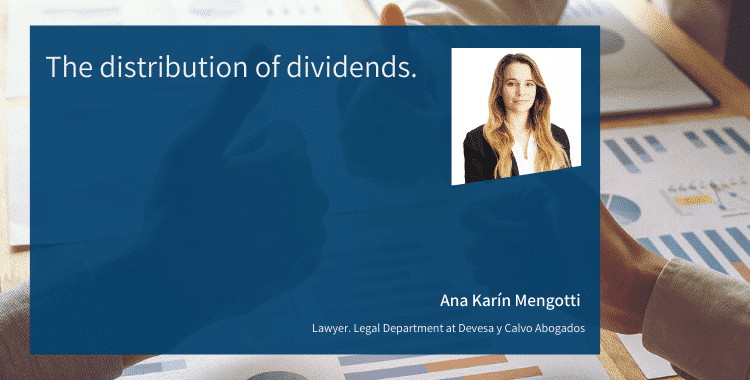
The distribution of dividends.
The participation of individuals and legal entities in a company is done with the hope that the company will make a profit.
Shareholders or partners are given the opportunity to collect the profits of the investment made in the company, established in our legal system as a mere expectation, by what we call dividends. These dividends are agreed at the General Meeting, by means of the legally required majority, ordinary majority (limited liability companies) and simple majority (public limited companies.), unless they are modified by the Articles of Association, and they come from the profits obtained by the company, the amount of which is distributed to the shareholders in the agreed percentages.
However, the distribution of dividends can only take place once the events listed below have been fulfilled, the purpose of which is none other than to ensure, as far as possible, the survival of the company.
Assumptions to be met before the distribution.
-
That there are profits from the entire business activity.
-
That there is a positive net asset. That is to say, that there are no negative results from previous years. If this is not the case, the profits must first be used to compensate losses. Likewise, dividends may only be distributed out of distributable profit if the value of the net equity is not, as a result of the distribution, less than the mercantile capital stock, as long as the other applicable financial and accounting criteria are fulfilled.
-
The stock, whether it is legal or obligatory, statutory or voluntary, is complied with, through the possibility of self-financing to cover possible risks. Unrestricted stock must be at least equal to the book value of the research and development assets shown in the balance sheet.
The distribution of dividends, which may be in cash or in kind, will be agreed at the General Meeting. As many believe, it will not be necessary to wait until the end of the year, but rather, agree the form and time of payment at the General Meeting. The maximum period will be of 12 months from the date of the agreement. Alternatively, in the event that this is not mentioned, it will be understood that it will be paid at the registered office on the day following the resolution. However, it must be taken into account that this right to the dividend prescribes after 5 years, counting from the first day on which it could have been charged.
The general rule is that in the limited liability companies (L.T.D) the distribution is made in proportion to the participation of each shareholder in the share capital, and in the public limited companies (P.L.C.) in proportion to the paid-up share capital. However, this general rule can be modified by the Articles of Association of the company, which can agree on another type of distribution, as long as the prohibition of “paco leonino” is not infringed by excluding any shareholder partner from its share in profit / loss.
If the Articles of Association establish a minimum dividend for certain shares, the holders of such shares will have priority over the rest at the time of distribution, including the remuneration for the administrators, who will be paid once the legal and statutory stock has been covered.
What happens if no distribution is made, or if it is made incorrectly?
In the event of an incorrect distribution, the dividends must be returned with legal interest rate, when the company proves that the recipients were aware of the irregularity of the distribution or that, given the circumstances, they could not have been unaware of it.
It is important to emphasize that, once the resolution has been agreed, the shareholder becomes a creditor against the company for its collection, and the General Meeting cannot subsequently modify or alter the resolution without the consent of the affected party.
In the event that no dividend distribution is made, and profits have been obtained during the three previous financial years, the minority shareholder will have the right to exercise its right of separation, unless otherwise provided for in the Articles of Association. In this regard, after the fifth financial year following the registration of the company in the Mercantile Registry, the shareholder who has recorded in the minutes its protest against the insufficiency of the recognized dividends, will have the right to withdraw if the General Meeting does not resolve to distribute as a dividend, of at least 25% of the legally distributable profits obtained during the preceding fiscal year.
However, even if the above circumstance occurs, the right of separation will not arise if the total of the dividends distributed during the last five years is equivalent to at least 25% of the legally distributable profits recorded during such period.
Lawyer. Legal Department at Devesa y Calvo Abogados
